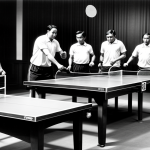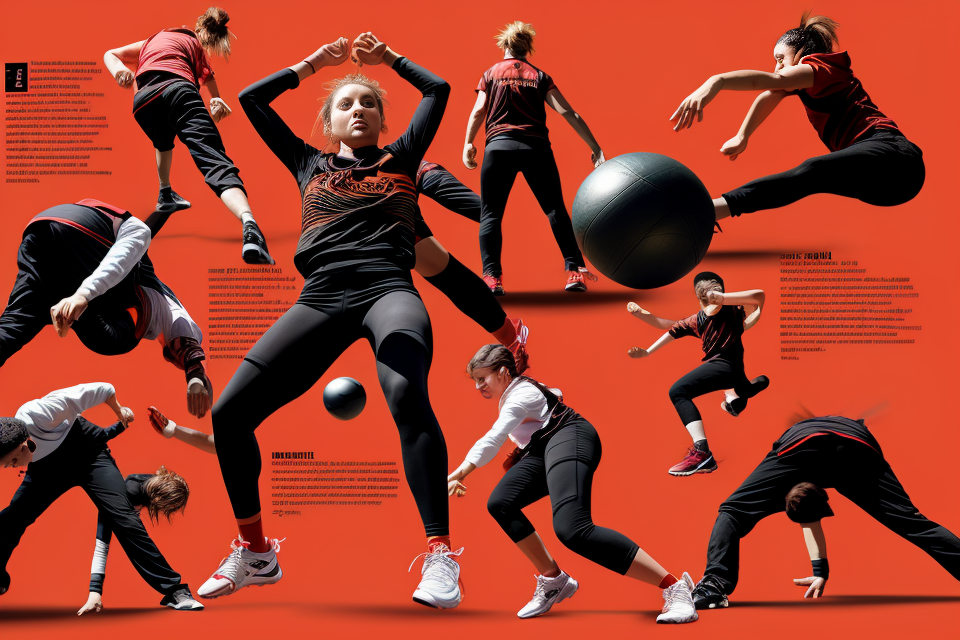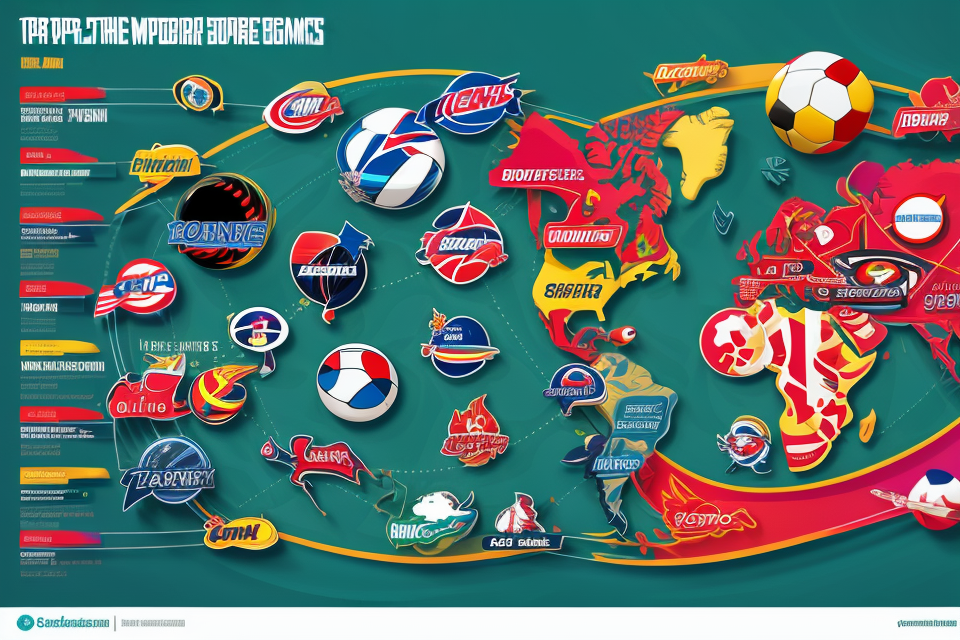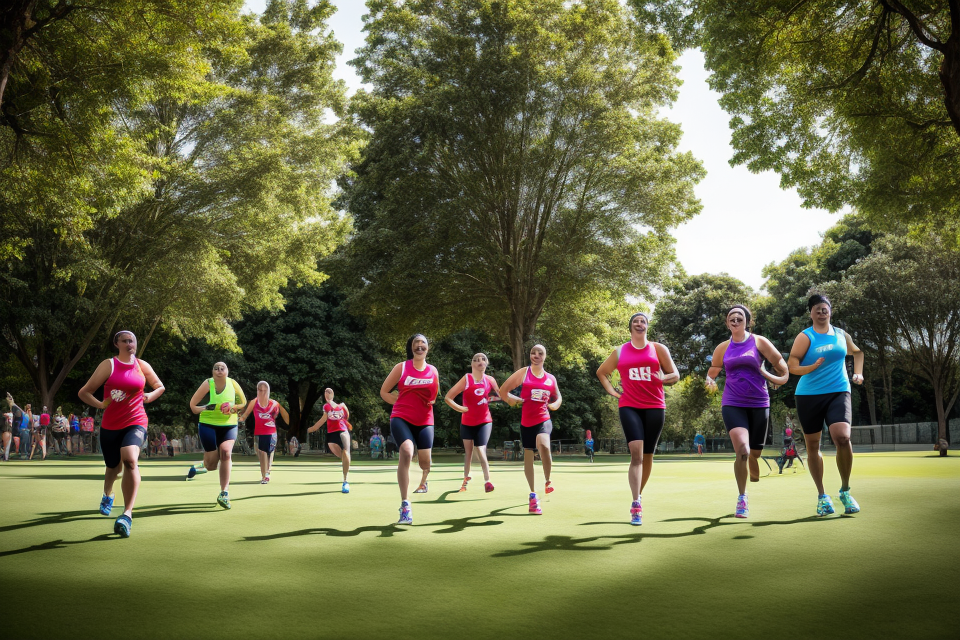When it comes to defining what activities should be considered a sport, opinions can vary greatly. Some argue that it requires physical exertion and competition, while others believe it can be any activity that promotes physical and mental well-being. In this article, we will explore the different perspectives on what makes an activity a sport and examine some of the most controversial cases. We will also discuss the importance of defining sports and how it impacts our society. So, whether you’re a seasoned athlete or just a sports enthusiast, read on to discover the exciting world of sports and what it takes to be considered one.
What is a Sport?
Definition of a Sport
A sport is generally defined as an activity or game that involves physical exertion and skill, with the aim of competing against another individual or team. However, the definition of a sport is not always clear-cut and can vary depending on who you ask. Some people may consider activities such as walking or hiking to be sports, while others may not. Similarly, some activities may be considered sports in certain cultures or countries, but not in others. Ultimately, the definition of a sport is subjective and can be influenced by various factors, including cultural, social, and historical contexts.
Criteria for an Activity to be Considered a Sport
There are several criteria that are commonly used to determine whether an activity should be considered a sport. These criteria include:
- Physical Activity: A sport is typically a physical activity that involves some degree of physical exertion.
- Competition: A sport is typically a competition between individuals or teams.
- Skill: A sport requires a certain level of skill, whether it be physical skill, mental skill, or both.
- Rules: A sport has a set of rules that govern the activity and ensure fair play.
- Spectator Interest: A sport generates interest from spectators, whether it be through television broadcasts, live events, or other means.
- Organization: A sport is typically organized by a governing body or organization that oversees the activity and its rules.
It is important to note that not all activities that meet these criteria are considered sports. For example, certain physical activities such as dancing or yoga may meet some of these criteria but are not typically considered sports. Additionally, some activities may meet all of these criteria but are not widely recognized as sports due to cultural or societal factors.
Physical Activities
Aerobic and Anaerobic Activities
Aerobic and anaerobic activities are two categories of physical activities that can be considered sports. Aerobic activities are exercises that require oxygen to produce energy, while anaerobic activities are exercises that do not require oxygen.
Aerobic activities include sports such as running, cycling, swimming, and rowing. These activities are characterized by repetitive movements that are sustained over a period of time. They are typically low-impact and have a low risk of injury.
Examples of popular aerobic sports include:
- Marathon running
- Triathlon
- Cycling
- Swimming
- Rowing
Anaerobic activities, on the other hand, are exercises that require short bursts of intense energy, such as weightlifting, sprinting, and jumping. These activities are typically high-impact and have a higher risk of injury.
Examples of popular anaerobic sports include:
- Weightlifting
- Powerlifting
- Sprinting
- Jumping
- Wrestling
Both aerobic and anaerobic activities have their own unique benefits and drawbacks. Aerobic activities are great for improving cardiovascular health and endurance, while anaerobic activities are better for building strength and power. Ultimately, the choice of which activities to consider sports depends on the specific criteria being used to define sport.
Strength Training and Weightlifting
Strength training and weightlifting are activities that involve the use of resistance to build muscle and improve physical fitness. These activities are often associated with the development of strength and power, and they can take many forms, from traditional weightlifting to bodyweight exercises like push-ups and squats.
One of the key elements of strength training and weightlifting is the use of resistance, which can come in the form of weights, resistance bands, or even bodyweight. By repeatedly performing exercises that place resistance on the muscles, the body adapts by building muscle tissue and increasing muscle strength.
In addition to building muscle and improving physical fitness, strength training and weightlifting can also have other health benefits. These activities can help to reduce the risk of chronic diseases like heart disease and diabetes, improve bone density, and increase overall physical function.
While strength training and weightlifting are often associated with competitive sports, they can also be pursued as a recreational activity or as a means of improving personal fitness. Whether done in a gym or at home, these activities can be tailored to meet the needs and goals of each individual, making them accessible to people of all ages and fitness levels.
Overall, strength training and weightlifting are activities that can provide many benefits, both physical and mental. Whether done for competition or personal enjoyment, these activities can help individuals to achieve their fitness goals and improve their overall health and well-being.
Flexibility and Stretching
Flexibility and stretching are physical activities that can be considered a sport. These activities involve the deliberate stretching of muscles and connective tissues to improve flexibility, range of motion, and overall physical fitness.
Flexibility training is a form of exercise that is focused on improving the range of motion of the joints and muscles. This can be achieved through a variety of techniques, including static stretching, dynamic stretching, and proprioceptive neuromuscular facilitation (PNF).
Static stretching involves holding a stretch for a period of time, typically for 15-30 seconds. This type of stretching can help to improve flexibility and range of motion in the muscles and joints.
Dynamic stretching involves moving through a range of motion in a controlled and fluid manner. This type of stretching can help to improve the coordination and control of the muscles and joints, and can also help to increase blood flow to the muscles.
PNF stretching is a type of stretching that involves the use of opposing forces to stretch the muscles and connective tissues. This technique can be very effective for improving flexibility and range of motion, particularly in the spine and hips.
Flexibility and stretching can be done alone or as part of a group or team activity. It can be incorporated into a wider fitness routine, or practiced as a standalone activity.
Overall, flexibility and stretching are important physical activities that can help to improve overall physical fitness and reduce the risk of injury. They can be considered a sport in their own right, and can be enjoyed by people of all ages and abilities.
Dance and Martial Arts
Dance and martial arts are two physical activities that have been a part of human culture for thousands of years. Both activities require dedication, discipline, and physical prowess, and have been recognized as sports by various governing bodies.
Dance
Dance is an art form that involves movement of the body in response to rhythm, music, or other stimuli. It has been a part of human culture since ancient times and has evolved into a wide range of styles, from traditional folk dances to modern dance forms like hip-hop and contemporary.
Dance is recognized as a sport by the International Olympic Committee (IOC) and is included in the Olympic Games as a demonstration sport. It requires strength, flexibility, balance, and coordination, as well as an understanding of rhythm and music.
There are many different types of dance, each with its own unique techniques and movements. Some of the most popular forms of dance include ballroom dancing, tap dancing, contemporary dancing, and salsa dancing.
Martial Arts
Martial arts are a set of combat sports and fighting techniques that originated in Asia and have since spread to other parts of the world. They involve physical movements and techniques that are designed to defend oneself against attackers.
Martial arts are recognized as sports by various governing bodies, including the World Anti-Doping Agency (WADA) and the International Olympic Committee (IOC). They require physical strength, endurance, flexibility, and mental focus.
There are many different types of martial arts, including karate, judo, taekwondo, kickboxing, and Brazilian Jiu-Jitsu. Each style has its own unique techniques and philosophies, and practitioners often specialize in one or more styles.
Both dance and martial arts require dedication, discipline, and physical prowess, and can be considered sports in their own right. While they may not be as popular as traditional sports like football or basketball, they are still important activities that contribute to physical fitness and cultural expression.
Swimming and Diving
Swimming and diving are two sports that are closely related but distinct from one another. Swimming is the sport of propelling oneself through water by means of the arms, legs, or other body parts, while diving is the sport of jumping or falling into water from a platform or springboard.
Swimming is one of the oldest sports in the world, with evidence of swimming dating back to ancient civilizations such as the Greeks and Egyptians. It is also one of the most popular sports in the world, with millions of people participating in it for recreation, fitness, and competition.
Swimming involves a combination of strength, endurance, and technique. Competitive swimming events include freestyle, backstroke, breaststroke, and butterfly, with each stroke requiring a different set of skills and techniques.
Diving, on the other hand, is a sport that requires both physical and mental strength. Divers must have the physical strength to perform the various somersaults and twists required in the sport, as well as the mental fortitude to conquer their fear of heights and the water.
Diving events include the 10-meter platform and the 3-meter springboard, with divers performing various maneuvers and acrobatics in the air before entering the water.
Both swimming and diving require a high level of physical fitness, technical skill, and mental toughness. They are both Olympic sports and are enjoyed by millions of people around the world.
Gymnastics
Gymnastics is a sport that involves the manipulation of the body in response to rhythm, music, or sounds, often with the use of gymnastic apparatus. It is a sport that has been around for centuries, with evidence of gymnastics-like activities dating back to ancient Greece. Today, gymnastics is a popular sport that is enjoyed by people of all ages and skill levels.
There are several different disciplines within gymnastics, including artistic gymnastics, rhythmic gymnastics, and trampoline gymnastics. Artistic gymnastics is the most well-known form of gymnastics and involves the performance of various movements on different apparatus, such as the balance beam, uneven bars, and floor exercise. Rhythmic gymnastics involves the manipulation of a hoop, ball, clubs, or ribbon in response to music. Trampoline gymnastics involves performing various acrobatic movements on a trampoline.
Gymnastics is a sport that requires strength, flexibility, balance, and coordination. It is a sport that requires dedication, hard work, and discipline, as well as a strong commitment to training and conditioning. Gymnastics also requires a high level of mental focus and concentration, as well as the ability to perform under pressure.
Gymnastics is a sport that is enjoyed by people of all ages and skill levels, from young children just starting out to elite athletes competing at the highest level. It is a sport that can be enjoyed recreationally or competitively, and it is a sport that offers many benefits, including improved physical fitness, increased flexibility and strength, and enhanced coordination and balance.
Overall, gymnastics is a sport that is both challenging and rewarding, and it is a sport that should be considered a true sport due to its physical demands, skill requirements, and competitive nature.
Track and Field Events
Track and field events are a collection of competitive physical activities that involve running, jumping, and throwing. These events are typically held in a variety of venues, including stadiums, arenas, and outdoor tracks.
Some of the most common track and field events include:
- Sprints: These are short-distance races, usually ranging from 60 to 400 meters. The most common sprint distances are 100m, 200m, and 400m.
- Middle-distance events: These races cover distances between 800m and 3000m, with the most common distances being 800m, 1500m, and 5000m.
- Long-distance events: These are races that cover longer distances, such as the marathon (42.195km) and the 10,000m run.
- Hurdles: These are races in which competitors must clear a series of barriers (hurdles) at various heights and distances.
- Relays: These are team events in which athletes compete in a relay format, with each member of the team running a specific distance before passing the baton to the next teammate.
- Field events: These events involve throwing or jumping, such as the shot put, discus throw, long jump, triple jump, and high jump.
In order to be considered a sport, an activity must have certain characteristics, such as physical exertion, competitive elements, and rules and regulations. Track and field events possess these characteristics, making them a prime example of a sport.
Other Physical Activities
While some physical activities are widely recognized as sports, there are others that are not as clear-cut. These “other physical activities” can include a variety of activities that may not fit neatly into traditional sports categories, but still involve physical exertion and competition.
One example of an “other physical activity” is dance. While some forms of dance, such as ballroom dancing, are considered sports, other forms, such as contemporary or hip-hop dance, are not. However, dance requires physical strength, endurance, and skill, and often involves competition, making it a contender for the title of sport.
Another example is martial arts. While activities like karate and judo are recognized as sports, other forms, such as aikido or tai chi, are not. However, these activities require physical fitness, technique, and often competition, making them viable candidates for sport status.
Additionally, activities like parkour and free running, which involve moving through obstacle courses and performing physical feats, could also be considered sports. While they may not have traditional rules or organizations, they require physical skill and endurance, and often involve competition among practitioners.
Overall, while some physical activities may not fit neatly into traditional sports categories, they still require physical exertion, skill, and often competition, making them contenders for sport status.
Mental Activities
Chess and Checkers
Chess and checkers are two of the most popular mental activities in the world. Both games require strategic thinking, critical analysis, and problem-solving skills. They are considered by many to be sports of the mind, and are often played competitively in tournaments and championships.
Chess is a game that has been around for over 1500 years, originating in India before spreading to Europe and the rest of the world. It is played on a square board with 64 squares of alternating colors, and each player has 16 pieces including a king, queen, rooks, bishops, knights, and pawns. The objective of the game is to checkmate the opponent’s king, which means to put the king in a position where it is in danger of being captured (in a manner of speaking) based on the specific moves and positions of the pieces on the board.
Checkers, on the other hand, is a simpler game that has been around for centuries and is believed to have originated in Egypt. It is played on an 8×8 board and each player has 12 pieces including two kings, two queens, two bishops, and two knights. The objective of the game is to capture all of your opponent’s pieces or to reach the opposite side of the board with your pieces.
Both chess and checkers require a high level of mental concentration and focus, as well as the ability to anticipate and react to your opponent’s moves. They are considered to be sports of the mind because they require physical exertion and mental exertion. While the physical exertion may be minimal, the mental exertion is significant, and it is the mental aspect of these games that sets them apart from other activities.
While chess and checkers are not traditionally thought of as physical sports, they do require a certain level of physical stamina and endurance. Players must be able to focus for long periods of time, often for hours on end, and must be able to think and react quickly to their opponent’s moves. This level of mental and physical exertion is what makes these games so challenging and rewarding for those who play them.
In conclusion, chess and checkers are mental activities that should be considered sports. They require strategic thinking, critical analysis, and problem-solving skills, as well as physical stamina and endurance. These games are not only enjoyable but also beneficial for improving cognitive abilities and mental well-being.
Go and Shogi
Go is a two-player strategy board game that originated in ancient China. The game is played on a grid of intersecting lines, and the objective is to surround more territory than the opponent. Players take turns placing black or white stones on empty intersections, with the goal of controlling the most territory by the end of the game. The game is won by having a larger number of connected stones than the opponent.
Shogi, also known as Japanese chess, is a two-player strategy board game that originated in India and was introduced to Japan in the 6th century. The game is played on a square board with 9 rows and 9 columns, and the objective is to capture the opponent’s king while protecting one’s own king. Players move their pieces, which include the king, queen, bishop, knight, and rook, across the board in a variety of ways, including diagonal moves and jumps over other pieces. The game is won by checkmating the opponent’s king, which means the king is in a position to be captured on the next move.
Both Go and Shogi require a high level of strategic thinking and planning, as well as the ability to adapt to changing circumstances on the board. They are often considered to be more of a mental activity than a physical one, but that does not necessarily mean they should be excluded from the definition of sport. In fact, many professional players of these games have achieved a level of skill and expertise that is comparable to that of elite athletes in traditional sports.
Bridge and Poker
Bridge and poker are two mental activities that have been widely recognized as sports by various organizations and communities. While they do not involve physical exertion, they require immense mental focus, strategy, and decision-making skills.
The Game of Bridge
Bridge is a card game played by four players in two partnerships. The objective of the game is to take tricks, which are cards played in a particular suit. Each player is dealt a hand of 13 cards, and the game is played over several tricks.
Bridge requires players to make strategic decisions based on the cards they hold and the moves made by their opponents. The game also involves a high degree of communication between partners, who must work together to achieve their objectives.
The Game of Poker
Poker is a card game played by one or more players. The objective of the game is to have the best five-card hand at the end of the game. Players can bet or fold based on the strength of their hand, and the game involves a degree of chance as well as skill.
Poker requires players to read their opponents’ behavior and make strategic decisions based on the cards they hold. The game also involves bluffing and deception, which can be a significant factor in determining the outcome.
Why Bridge and Poker are Considered Sports
Bridge and poker are considered sports because they require a high degree of physical and mental skill. While they do not involve physical exertion, they require immense mental focus, strategy, and decision-making skills.
Players must be able to read their opponents’ behavior, anticipate their moves, and make strategic decisions based on the cards they hold. Both games require a significant amount of practice and dedication to master, and players must have a deep understanding of the rules and strategies involved.
In addition, both bridge and poker have organized competitions and tournaments, with recognized governing bodies and rules. The World Bridge Federation and the World Poker Tour are examples of organizations that promote and regulate these activities as sports.
In conclusion, while bridge and poker may not involve physical exertion, they are sports that require immense mental focus, strategy, and decision-making skills. Both games have organized competitions and tournaments, and players must have a deep understanding of the rules and strategies involved to succeed.
Other Mental Activities
In addition to the traditional sports such as football, basketball, and tennis, there are several other mental activities that could be considered sports. These activities often involve strategy, problem-solving, and mental acuity, as well as physical exertion in some cases. Some examples of these activities include:
- Chess: A game of strategy and skill, chess involves moving pieces across a board in order to capture the opponent’s pieces and checkmate their king. Physical exertion is not a factor in chess, but mental focus and strategic thinking are essential to success.
- Puzzles: Puzzles come in many forms, from crosswords and Sudoku to jigsaw puzzles and Rubik’s cubes. These activities require mental agility and problem-solving skills, and can be just as challenging and rewarding as physical sports.
- Debate: Debate involves presenting arguments and counterarguments on a given topic, with the goal of persuading the audience to accept one’s perspective. Physical exertion is not a factor in debate, but mental agility, quick thinking, and strategic planning are essential to success.
- Trivia: Trivia contests involve answering questions on a wide range of topics, from history and science to popular culture and sports. These activities require mental agility, knowledge, and quick thinking, and can be just as challenging and rewarding as physical sports.
While these activities may not involve physical exertion to the same degree as traditional sports, they require a great deal of mental acuity and strategic thinking. As such, they could be considered sports in their own right, and could be just as valuable for promoting physical and mental health as traditional sports.
Hybrid Activities
Tennis and Badminton
Tennis and badminton are two popular hybrid activities that involve both physical and mental skill. While they may appear similar, they have distinct differences in terms of equipment, court size, and playing style.
Equipment and Court Size
Tennis is played on a rectangular court using a racket and a ball. The court measures 78 feet (24 meters) long and 27 feet (8.2 meters) wide for singles play, and 36 feet (11 meters) wide for doubles play. The ball used in tennis is also larger than the one used in badminton, measuring 2.75 inches (7 cm) in diameter.
Badminton, on the other hand, is played on a rectangular court that measures 16.4 feet (5 meters) wide and 44 feet (13.4 meters) long. The court is divided by a net that stands at 5 feet (1.5 meters) tall in the center. Players use a racket and a shuttlecock made of feathers or synthetic materials to hit the ball back and forth. The shuttlecock used in badminton is smaller than the one used in tennis, measuring 2.5 inches (6.3 cm) in diameter.
Playing Style
The playing style of tennis and badminton differs significantly. Tennis is a fast-paced game that requires players to cover large distances quickly. It involves rallies that can last up to 20 shots or more, with players using various spins, slices, and volleys to outmaneuver their opponents. Tennis is also a physically demanding sport that requires players to have excellent footwork, endurance, and strength.
Badminton, on the other hand, is a slower-paced game that emphasizes accuracy and precision. The court is smaller than that of tennis, which means players must be close to the net to hit the shuttlecock. The game involves short rallies, with players using quick footwork and precise shots to outmaneuver their opponents. Badminton also requires players to have excellent hand-eye coordination, as well as good reflexes and timing.
In conclusion, while tennis and badminton may appear similar, they have distinct differences in terms of equipment, court size, and playing style. Both sports require physical and mental skill, and are enjoyed by millions of people around the world.
Basketball and Volleyball
Basketball and volleyball are two sports that share similarities in terms of their rules and gameplay, but also have distinct differences that set them apart.
Basketball
Basketball is a sport played by two teams of five players each on a rectangular court. The objective of the game is to score points by shooting a ball through a hoop located at each end of the court. The team with the most points at the end of the game wins.
The game of basketball was invented in 1891 by Canadian physical education instructor James Naismith. The first official game of basketball was played in December of that year at the International YMCA Training School in Springfield, Massachusetts. The game has since grown in popularity and is now played by millions of people around the world.
Basketball is a fast-paced sport that requires a combination of skill, strength, and endurance. Players must be able to dribble the ball, shoot, and pass accurately, as well as defend their opponents and rebound off the boards.
Volleyball
Volleyball is a sport played by two teams of six players each on a rectangular court. The objective of the game is to score points by hitting a ball over the net and landing it on the opponent’s court. The team with the most points at the end of the game wins.
The game of volleyball was invented in 1895 by William G. Morgan, a YMCA physical education director in Holyoke, Massachusetts. The first official game of volleyball was played in 1896 at Springfield College in Massachusetts. The sport has since become popular around the world and is played by millions of people of all ages and skill levels.
Volleyball is a high-intensity sport that requires a combination of strength, agility, and coordination. Players must be able to hit the ball with precision, block opponents’ shots, and dig the ball off the court.
While both basketball and volleyball are considered hybrid activities, they have distinct differences that set them apart. Basketball is played on a court with a hoop at each end, while volleyball is played on a court with a net in the center. Additionally, basketball involves dribbling and shooting, while volleyball involves hitting and blocking.
Hockey and Rugby
Hockey and rugby are two hybrid sports that have similar origins and share many similarities in terms of rules and gameplay. Both sports are played on a field with a ball and involve physical contact between players. However, there are also significant differences between the two sports that set them apart.
In hockey, the objective is to score goals by hitting the ball into the opposing team’s net using a stick. The game is played with six players on each team, and players are not allowed to touch the ball with their hands. Instead, they use their sticks to control the ball and pass it to their teammates. The game is fast-paced and requires a high level of endurance and physical fitness.
Rugby, on the other hand, is a full-contact sport where the objective is to score tries by carrying the ball over the opposing team’s goal line. The game is played with 15 players on each team, and players are allowed to use their hands to catch and carry the ball. The game is also fast-paced and requires a high level of physical fitness and skill.
While both sports have similarities, they also have distinct differences that make them unique. Hockey is more focused on individual skill and strategy, while rugby is more focused on physicality and teamwork. Despite these differences, both sports are considered to be high-intensity, competitive activities that require a high level of physical fitness and skill.
Soccer and Football
Soccer and football are two sports that share many similarities, but also have distinct differences. Both sports involve kicking a ball into a goal, but the rules and strategies used in each sport are unique.
In soccer, the ball can be kicked or headed into the goal, and players are not allowed to use their hands. The game is played with 11 players on each team, and the objective is to score more goals than the opposing team. The field is rectangular, and the goal is located in the center of each end.
In football, the ball can be carried, kicked, or thrown into the goal, and players are allowed to use their hands to catch and carry the ball. The game is played with 11 players on each team, and the objective is to score more points than the opposing team. The field is oval-shaped, and the goal is located at each end of the field.
While both sports share some similarities, the differences in rules and strategies make them distinct activities that require different skills and techniques. Whether you prefer soccer or football, both sports offer a fun and challenging way to stay active and compete with others.
Other Hybrid Activities
When discussing hybrid activities, it is important to acknowledge that there are a variety of activities that may not fit neatly into the traditional definitions of either sport or recreation. These activities may incorporate elements of both, making them unique and challenging to categorize. In this section, we will explore some of these other hybrid activities and examine how they challenge our understanding of what constitutes a sport.
Aerobics
Aerobics is a form of exercise that combines elements of dance and cardiovascular conditioning. Developed in the 1960s, aerobics has evolved into a popular form of exercise that is often taught in gyms and fitness centers. While some may argue that aerobics is primarily a form of exercise, others may consider it a sport due to its competitive nature and the presence of professional aerobics competitions.
Martial arts are a group of disciplines that involve physical combat and self-defense techniques. Including activities such as karate, judo, and taekwondo, martial arts can be considered a hybrid activity due to their incorporation of physical activity, technique, and strategy. While some may argue that martial arts are primarily a form of self-defense or physical fitness, others may consider them a sport due to their competitive nature and the presence of professional martial arts tournaments.
DanceSport
DanceSport is a competitive form of ballroom dancing that has gained popularity in recent years. Combining elements of traditional ballroom dancing with the rules and regulations of a sport, DanceSport has developed into a recognized sport with international competitions and professional dancers. While some may argue that DanceSport is primarily a form of dance or performance art, others may consider it a sport due to its competitive nature and the presence of rules and regulations governing the activity.
In conclusion, while some hybrid activities may be more easily categorized as either a sport or recreation, others may challenge our understanding of what constitutes a sport. Activities such as aerobics, martial arts, and DanceSport incorporate elements of both physical activity and competition, making them unique and challenging to categorize.
Future Research Directions
While the definition of a sport has been a topic of debate for some time, the rise of hybrid activities has introduced new challenges to this definition. As hybrid activities continue to gain popularity, it is important to explore the future research directions that can help us better understand how these activities should be classified.
Identifying the Characteristics of Hybrid Activities
One potential area of research is to identify the characteristics of hybrid activities that distinguish them from traditional sports. This could involve analyzing the rules, equipment, and scoring systems used in these activities, as well as the skills and physical abilities required to participate. By identifying the unique features of hybrid activities, we can better understand how they differ from traditional sports and whether they should be considered a separate category.
Developing a Framework for Classifying Hybrid Activities
Another potential area of research is to develop a framework for classifying hybrid activities. This could involve creating a set of criteria that can be used to determine whether an activity should be considered a sport or not. These criteria could include factors such as the level of competition, the degree of skill and strategy involved, and the physical demands of the activity. By developing a framework for classifying hybrid activities, we can ensure that these activities are accurately categorized and that athletes are given the recognition and support they deserve.
Examining the Impact of Hybrid Activities on Traditional Sports
Finally, future research could explore the impact of hybrid activities on traditional sports. As these activities continue to gain popularity, they may begin to attract more participants and funding, potentially leading to changes in the way traditional sports are played and organized. By examining the potential impact of hybrid activities on traditional sports, we can better understand how these activities may influence the future of athletics and whether they should be considered a separate category or integrated into existing sports.
Overall, future research directions in the area of hybrid activities will be critical in helping us better understand how these activities should be classified and how they may impact traditional sports. By exploring these topics, we can ensure that athletes are given the recognition and support they deserve, regardless of the activity they choose to participate in.
FAQs
1. What is the definition of a sport?
A sport is generally defined as an activity that involves physical exertion and competition, with the aim of improving or demonstrating physical ability and skill. It often involves a set of rules and regulations, and can be played individually or as part of a team.
2. What activities are considered sports?
There is no definitive list of activities that are considered sports, as it can vary depending on the source and the context. However, most people would consider activities such as football, basketball, tennis, swimming, gymnastics, and athletics as sports.
3. What are the criteria for an activity to be considered a sport?
The criteria for an activity to be considered a sport can vary, but some common factors include physical exertion, competition, skill, and rules. It should also have a recognized governing body or organization that oversees its development and competition.
4. Are there any activities that are not considered sports?
Yes, there are activities that are not considered sports. For example, activities that are purely recreational, such as walking or hiking, are not typically considered sports. Activities that are purely mental, such as chess or puzzle-solving, are also not considered sports.
5. Why is it important to define what activities are considered sports?
Defining what activities are considered sports is important because it helps to establish a common understanding and language around the concept of sport. It also helps to ensure that activities are given appropriate recognition and support, whether that be through funding, resources, or media coverage.










